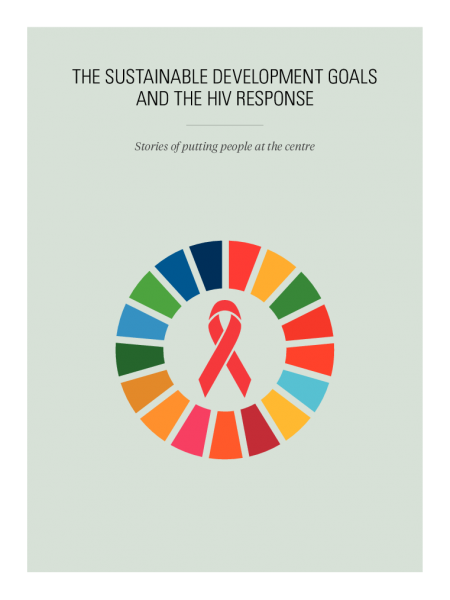The 2030 Agenda for Sustainable Development takes to scale what the AIDS response has been working towards for 30 years—a multisectoral, rights-based, people-centred approach that addresses the determinants of health and well-being. The individual stories in this series highlight the linkages between HIV and related Sustainable Development Goals (SDGs), each told from the personal perspective of people affected by HIV. The series paints a picture of how interconnected HIV is with the SDGs and how interdependent the SDGs are with each other. Most importantly, the stories show us the progress we have achieved with the AIDS response and how far we have left to go with the SDGs.
When friends and family stopped coming to Mona Balani’s house, she was stoic. But worse was to come when no one would play with her six-year-old.
“My elder son had to face so much discrimination at that time,” Mona recalled, when she and her husband tested positive for HIV in 1999. “Relatives would say nasty things to him: ‘Your parents will die one day, and you will die too’.”
Holding back tears, she remembered that every time she came home in the evening, her son would hug her and ask her not to leave him alone. Mona’s husband had been sick off and on for three years. He was eventually diagnosed with TB. Because of the couple’s HIV status, sometimes medical staff would refuse to admit him to the hospital.
“More than once, doctors, nurses or lab technicians made objectionable sexual remarks,” Mona said. Because of how people responded to them, they often felt like they had committed a crime.
Meanwhile her youngest son became sick and was later diagnosed with TB. Mona explained that the mounting costs of medicines for her husband and her two-year-old meant she could not afford HIV treatment for herself as well.
Sadly, her youngest son died a month later. “I knew I had to overcome everything and move forward and live for my older son,” she said.
In 2002 Mona found out that she too had TB of the lungs. She began and completed treatment within the stipulated six-month period. Three years later, Mona’s husband’s condition worsened. He passed away in 2005. Her ordeal did not end there. The following year she developed abdominal TB.
“When I was getting tested for TB I had to be admitted to the hospital for a night to get my diagnosis done, but after looking at my HIV status the staff declined to take me in,” Mona said. She called a retired doctor she knew, who contacted a colleague of his so that she could stay.
“Even after admitting me, the doctor who examined me asked me to replace all the equipment used and the bedsheet from the bed. The doctor would always wear double gloves before examining me,” recalls Mona.
By then, Mona had been on antiretroviral therapy and she started her TB treatment. She also decided she could help fight stigma surrounding TB and HIV.
In 2007 she began working with the Network for People Living with HIV/AIDS in remote areas of Rajasthan. Ten years later she lives in New Delhi and works for the India HIV/AIDS Alliance. She dreams of a world where people affected by HIV and TB have rights and are respected and can lead normal lives, ensuring healthy lives and well-being for all at all ages.
“People think that HIV only leads to death, but that is not true,” Mona said. “I proved to the world that you can live a healthy life with HIV, and I am still leading a healthy life.”

SDG 3: Ensure healthy lives and promote well-being for all at all ages
Good health is a prerequisite for progress on ending AIDS. Ensuring healthy lives and promoting well-being for all at all ages, including people living with or at risk of HIV, is essential to sustainable development. For example, successfully ending the AIDS epidemic will require enormous health service scale-up, with a focus on community services, targeted testing strategies, ensuring treatment is offered to people following diagnosis (including regimes appropriate for babies, children and adolescents), and regularly support and monitoring for people on antiretroviral medicines. Eliminating mother-to-child transmission of HIV depends on providing immediate treatment to pregnant women living with HIV, integrating HIV and sexual and reproductive health services, and engaging male partners in prevention and treatment services.
Increasing service integration in a way that responds to individuals’ needs—whether that be combining tuberculosis (TB) and HIV services or providing youth-friendly HIV, sexual and reproductive health services—leads the way in reshaping efficient, accessible and equitable health services for HIV and beyond. HIV can be ended only by promoting the right of all people to access high-quality HIV and health services without discrimination.
The following stories explore how inextricably linked SDG 3—ensure healthy lives and promote well-being for all at all ages—and ending AIDS are. For every individual, protecting and maintaining good health underpins the capacity to fulfil their multiple roles within family, community, society and the economy. Mona’s story recounts her struggles with HIV and TB, discrimination, and the right to be treated fairly and with dignity. Lidia works with partners in the health services, community health system and private sector to ensure female seasonal coffee pickers are given the information and services they need to prevent mother-to-child transmission of HIV. Sergey describes his experience of how a harm reduction programme helped him overcome his addiction while adhering to antiretroviral therapy. Christine tells her story of how, as a community health worker, she reaches out to women where and when they need her to prevent mother-to-child transmission.




